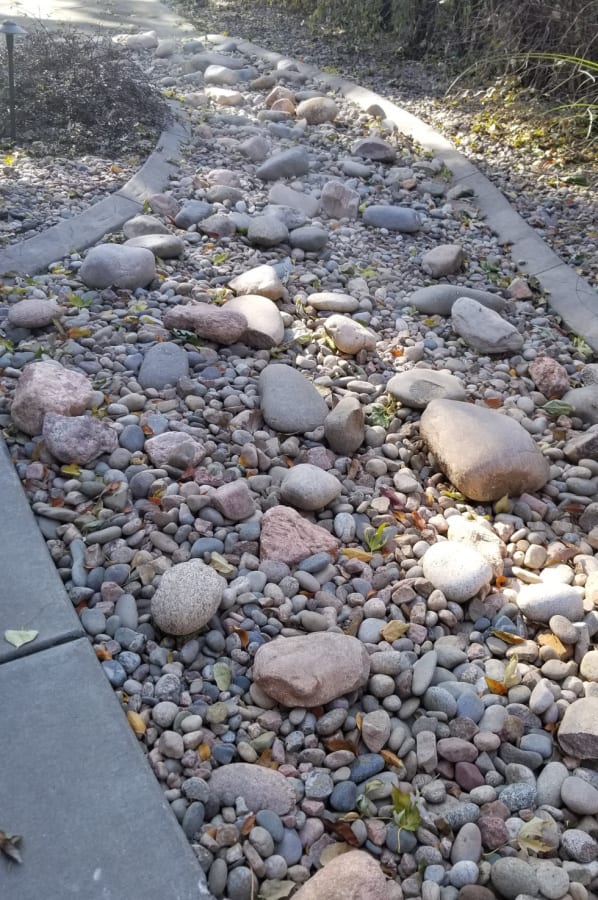Dry streams are a way to hide or transform water using locations within the garden. These areas are not rain gardens, but low and sloped spots that water runs through quickly after a rain. It might be the location of the downspout outflow, a sloped spot in a level lawn, or a drainage swale used to carry water away from the house. Any of these and more.
I have designed and built dry streams for all manner of places, in Kansas, Nebraska, and Minnesota. In one instance, we used a large downspout outflow spot to put in a dry stream and waterfall. It was only a waterfall when it rained, but it was a beautiful creation.
There are several factors that must be assessed and remembered when designing and building one of these dry streams. You need to be able to determine slope, water runoff placement, what kind of rock or boulders to use, and planting. Dry streams are extremely useful for channeling water away from a spot, but you need to know where it is going also.
Finding Slopes in the Landscape
One of the easiest ways to find where the water runs in your landscape is to watch it when it is raining. Go outside in a big rain, and watch where and how the water flows. The purpose of the dry stream is to channel water when it is raining, to prevent soil erosion and direct water to another location. The other location may be sewer or storm drains, a running creek or stream, or a pond or lake. Mark where the water runs while raining with flags or other markers. These will help you determine where to place the dry stream.
Another way to look for where to place dry streams is to look for areas of soil erosion or gullying in your landscape. If you find these areas, they are prime examples of where to put a dry stream. We have had customers who tried turf in an area off a heavily sloped concrete driveway, and had to finally put in a dry stream. These areas get lots of water moving quickly in just a small storm, because the surface area of the concrete is collecting and moving lots of water.

What Goes into a Dry Stream?
But what are dry streams made from? Simply, a dry stream is built with a layer of porous landscape fabric (not pond liner), overlaid with boulders and large gravels to look like a stream. You can use specialty rocks to make it look imitate water from a distance. Or you can simply match local rock. I like to pick rock that matches the overall landscape or house architecture.
The landscape fabric does not matter, as long as it lets small amounts of water through, and it UV resistant. As for rock and boulders, there are several types you may need to pick from.
- Colorado rock is very colorful. It is usually rounded and comes in varying sizes.
- Iowa River rock is also very colorful, but it has larger, more squared sides.
- Kansas river rock has tones of gray, white, red, and brown, and it flattened and sharp.
- Mexican beach pebbles are dark gray to black stones, which are rounded and used to create the idea of flowing water.
- Pea gravel is small and colorful, but usually too small for dry streams.
- Limestone boulders and capstones should not be used unless rainfall per year is low. They erode quickly in heavy rainfall areas.

Boulder Placement Along a Dry Stream
One of the most difficult things I see landscapers struggle with is boulder placement. Most just drop large boulders on top of the ground or weed barrier, and surround them with smaller gravels and rocks. This is the wrong way to do it. You want the boulders to look as if they have always been there. Not as if they just fell out of the sky and into the landscape.
When building dry streams, I like to plan for big boulders first, even before the laying of fabric. This insures that you make the boulders appear natural, not random. Dry streams should lengthen the runoff area your are trying to fix. This means that you should not have too short of a distance to fill with stone.
Place large boulders about where you think they would look best. On narrow streams, place them along the edge about every 3 to 6 feet, depending on run length. For streams wider than 3 feet, you may want to add some boulders within the stream, to slow the flow of water.
Once you have the boulders where you want them, pull them back a few feet. Then dig a hole to cover 1/4 to 1/3 of the boulder. This should be done for any boulders bigger than 2 feet by 2 feet in size. After the holes are dug, you put down the weed barrier or fabric, then replace the boulder in the hole. This helps make the boulder look more natural and it helps hold down the fabric.

Placing Smaller Boulders
Smaller boulders can be grouped next to big boulders, or laid along the stream in their own spots. But all the boulders should have smaller boulders placed next to them to make it look more natural. If you went to a mountain stream, you would see such groupings of stones, brought together by flash floods.
Putting Down the Fabric and Smaller Stones
After boulder holes are dug, use landscape fabric or weed barrier to keep stones and soil separate. This prevents mud getting into the rock and will prevent more soil erosion problems in the future. Lay the fabric down so that it covers the sloped area of the stream, both lengthways and width. Make sure to go at least 6 inches wider on both sides of the width, to prevent soil from eroding the sides.
Once the fabric is placed, put the big boulders back into their holes, and arrange smaller boulders in groupings. There should be varying sizes of boulders in groupings along the whole length of the stream. Also, smaller boulders should be placed in groupings within the stream to slow water movement down.
If the slope of the stream is too steep, over 30o of more, then put large boulders every 2 feet in the stream to slow the water down. Water can mover very fast in a specific direction, and the steeper the slope, the faster it will move.
Laying River Rock in Dry Streams
River rock and smaller stones, less than 12 inches across should be placed last within the stream. These can be dumped in. Or, in the case of Mexican beach pebbles, arranged to fill the space to make it look like moving water when it is dry.
Try to match the smaller stones and gravels to the boulders. For example, do not mix Kansas river rock with Colorado boulders. Nor should you mix pea gravel with Mexican beach pebbles and pink granite. The following lists some good combinations for dry streams.
- Limestone boulders with Mexican beach pebbles
- Colorado boulders and Colorado river rock
- Colorado boulders and Mexican beach pebbles
- Limestone boulders and Kansas river rock
- Pink granite boulders and Iowa river rock
- Colorado boulders and Iowa river rock

Plantings Along Dry Streams
Now that you have all your rock laid, you can begin to think about plantings along the stream. I do not recommend planting anything within the stream, unless it has a very gradual slope of less than 10o and only if the plants can survive with little soil to root connections. This is because water moves through and will remove soil particles quicker than anything else. Plants within the stream should be placed in soil reservoirs dug before the fabric laying, but filled after. Then topped with screening and rocks to prevent soil loss. Also, these plants should be able to handle both drought and wet extremes.
It is better to plan to plant along the edges, than try to fill the stream itself with plants. For the edges, you will want to pick plants that do not spread aggressively by rhizomes, nor those which will overshadow the look of the stream. Use plants that soften the edges, and enhance the look of the stream.
Plants for Dry Stream Edges
Grasses and Sedges
- Prairie Dropseed
- Little bluestem
- Blue grama ‘Blonde Ambition’
- Hakonechloa grass
- Cedar Sedge
- White-tinged sedge
Shade Perennials
Sun Loving Perennials
- Daylily
- Lavender
- Torch Lily
- Ornamental Onion
- Alyssum
- Silver mound
- Butterfly milkweed
- Chrysanthemum
- Threadleaf Coreopsis
- Lanceleaf Coreopsis
- Dianthus
- Siberian iris
- Japanese iris
- Louisiana iris
- Cardinal flower
- Salvia
- Rudbeckia ‘American Gold Rush’
- Sedum
- Ironweed ‘Iron Butterfly’
Small Weeping Trees and Shrubs
- Redbud ‘Lavender Twist‘ and ‘Vanilla Twist’
- Weeping baldcypress
- Weeping Norway spruce
- Pussy willow ‘Pendula’
- Peach ‘Pink Cascade’
- Aralia ‘Sun King’
- Slender deutzia
- Falsecypress
- Bird’s nest spruce
Maintaining Dry Streams
What kind of maintenance should I expect on my stream?
Dry streams have little maintenance yearly. The most important thing is to keep as much leaf debris and soil from getting between the rocks as possible. This means than you need to clean out the leaves in the fall and winter as much possible. If you have a leaf vacuum, it will help, just be careful not to suck up any rocks.
For the plantings around your stream, most perennials can be cut back in the spring, in March or April. Plants that I recommend cutting back in fall include daylily, hosta, iris, and bleeding hearts. These are early spring risers, and can be difficult to clean up in spring.
Boulder and Rock Movement
Sometimes you will get flash floods or extremely heavy rains which may dislodge smaller stones and boulders. If you boulders are large enough (greater than 3 feet across) and your stream run is less than 10 feet, you should not have to worry about the larger stones. But smaller stones may move in heavy rains, and will need to be replaced as soon as possible afterwards. If necessary, replace dislodged stones with larger stones to prevent future movement.
Conclusion
Putting together dry streams to channel water away from the house and keep soil erosion at bay can is functional and fun. These streams become an important part of the landscape, and often add a pleasing element which may not have been there before.
Happy planting!




